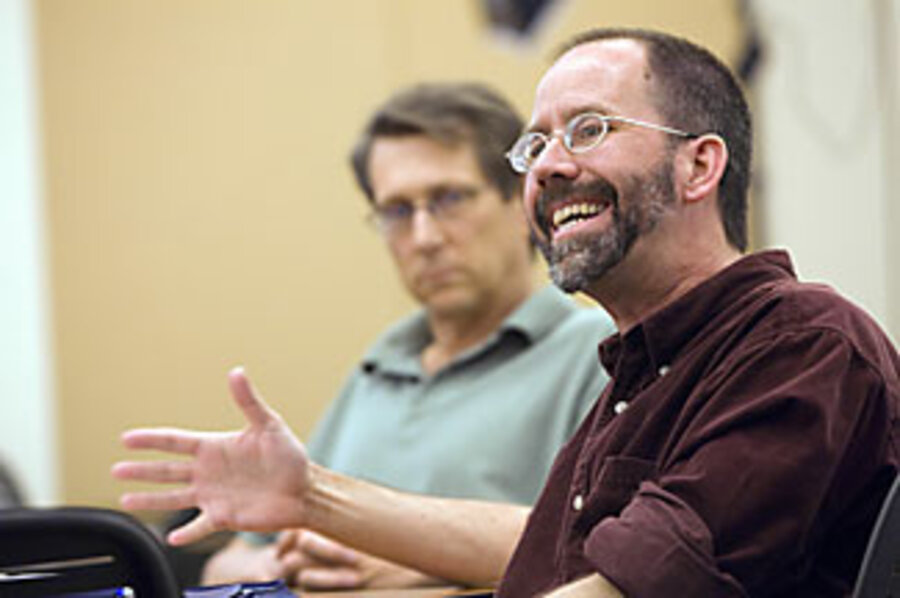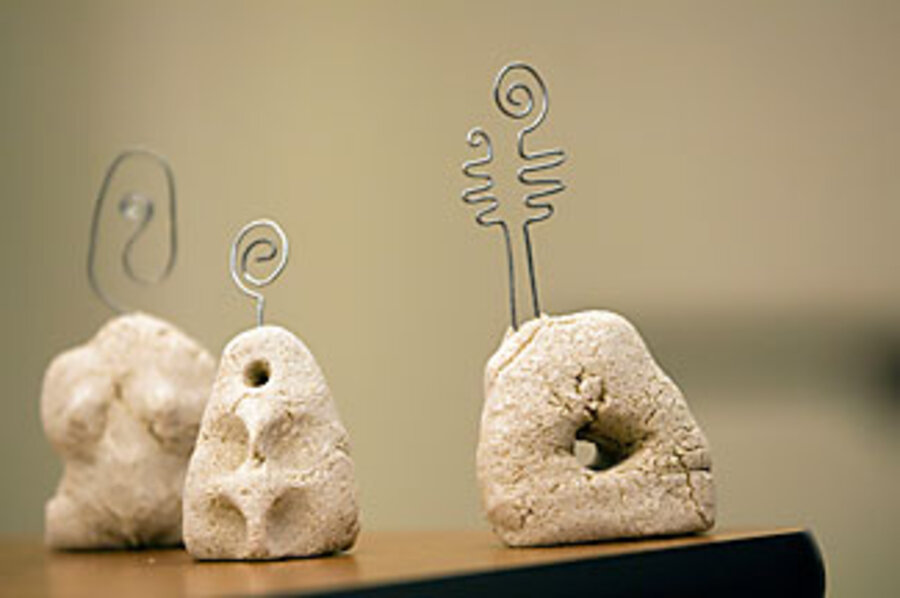Creative writing for extraterrestrials
Loading...
| Laramie, WYO.
On the windswept campus of the University of Wyoming, spring is struggling to arrive, students are fighting their way through finals, and Jeffrey Lockwood's creative writing class is grappling with how to talk to aliens. And they're not kidding.
"So, what this is really about is a cosmic first date?" Professor Lockwood teases the class. "You want to look good, but not fake?"
His 11 students, gathered for their final meeting of the semester, are discussing how to describe humanity to other civilizations. Should they put our best collective foot forward, and tell stories that illustrate altruism and romantic love? Should they also explain lying and warfare?
There are no easy answers. "I leave here with a headache a lot," says graduate creative-writing student Christina Ingoglia. "We're always constructing our audience. We can't assume a basic understanding of language – we can't assume anything."
During one of the semester's first classes, Lockwood asked the students to summarize the human condition in 250 words, then 50, then 10. While some students chose the poetic – "We are an adolescent species searching for our identity," wrote English major Ann Stebner – Ms. Ingoglia stuck with the anatomical. "Two arms, two legs, head, torso, symmetrical," she thought, would be a safer way to introduce humanity to an unknown world. "Then I realized that we're sending out all sorts of messages anyway, through radio waves," Ingoglia says, and she got bolder.
One of her projects, a series of fictional eulogies, takes a core sample of human diversity, describing the lives and deaths of an infant, a drag queen, an American soldier, and others through the eyes of loved ones.
English 4050/5560, otherwise known as "Interstellar Message Composition," is the first class to enlist creative writers in a potential cosmic conversation. Funded in part by the National Aeronautics and Space Administration's Wyoming Space Grant Consortium, it's designed to fill a practical – if extremely theoretical – need. "We've thought a lot about how we might communicate with other worlds, but we haven't thought much about what we'd actually say," says Lockwood, a professor of natural science and humanities.
Humans have dreamed about conversing with extraterrestrials for centuries. We've considered lighting kerosene-filled canals in the Sahara Desert; we've listened for radio signals from Mars; and we've sent NASA spacecraft aloft with representations of human beings and the solar system, and recordings of the Brandenburg Concerto and "Johnny B. Goode."
In recent decades, while a few scientists have deliberately sent specific radio messages skyward, most have allowed humanity's daily buzz of signals to speak for itself. Extraterrestrial communication, after all, has significant political implications, and researchers have found it less controversial, and more efficient, to simply listen to the universe. But as powerful radiotelescopes allow astronomers to study stars in greater numbers and at greater distances, the chances of running into another civilization – while still considered infinitesimal – are better than ever.
"It could be tomorrow that we'll need to be ready to decide if we should reply," says Douglas Vakoch, director of interstellar message composition for the nonprofit SETI (Search for Extraterrestrial Intelligence) Institute in Mountain View, Calif.
Dr. Vakoch, who advises and has visited Lockwood's class, says decisions about whether and how to answer shouldn't be made by researchers alone. "I think it's really critical to have people start thinking about it – and it makes sense to start with writers," he says. "These are people who are really trying to express the human condition."
The work of creative writers could also inspire a more interesting conversation. "If all we end up talking about is 'Yeah, we know the Pythagorean theorem, too,' I'll be disappointed," says Lockwood. "I want to know something that challenges my parochial views of the universe."
In Lockwood's classroom, the questions continue. How might extraterrestrials communicate? Would they be able to see and hear, or only see, or have a sense completely foreign to us? Might they have technology able to translate human language, or would they better understand messages written in mathematical patterns, or with an extremely limited vocabulary? Through the semester, the students have experimented with all these possibilities. Graduate student Dixie Thoman presents a poem about menstruation, with syllables arranged in a Fibonacci sequence, and a poem that describes giving birth in only four words: pain, loud, force, breath.
The class, which includes a buffalo rancher, a university accountant who sculpts in his spare time, and psychology and journalism students alongside the creative writers, often disagreed. For the first several weeks of the class, English major Spencer Pittman argued against sending any fiction or poetry into the cosmos, favoring encyclopedia-style entries instead. "Why bother with another layer of cryptology?" he asks.
But in the course of the semester, he's changed his mind. "There are some things you can't convey without art," he says now.
The students ultimately discovered more commonalities than differences. "Birth came up a lot, death came up a lot," says Marissa Johnson-Valenzuela, a graduate student in creative writing. "We found out what's left when you take away all the minor stuff." And they all came to agree that when it comes to communicating big ideas, it's best to start small, with stories rather than grand abstractions.
Lockwood, who trained as an entomologist before venturing into philosophy and creative writing, found that the class drew on all his disparate interests. "Some insects can see into the ultraviolet spectrum, and can't see red light – others are acutely sensitive to odors, while we're basically blind to odors," he says. "Their world is not our world, and in some ways that primed me to be very interested in what it is to think and understand in a way that's radically different from our own."
After the close of the semester, the students will send their writings to Vakoch and his colleagues at the SETI Institute, where their efforts may one day inspire a message to another world. While the chances of their stories, poems, and reflections finding a nonhuman audience are extraordinarily slim, Lockwood says that even the whisper of that possibility has kept his class engaged with the problem. And if his students' work is never heard – or understood – by its intended recipients, they'll still have learned something about the fundamental difficulties of interpersonal communication.
"In a sense," Lockwood says, "all writing is writing for extraterrestrials."






